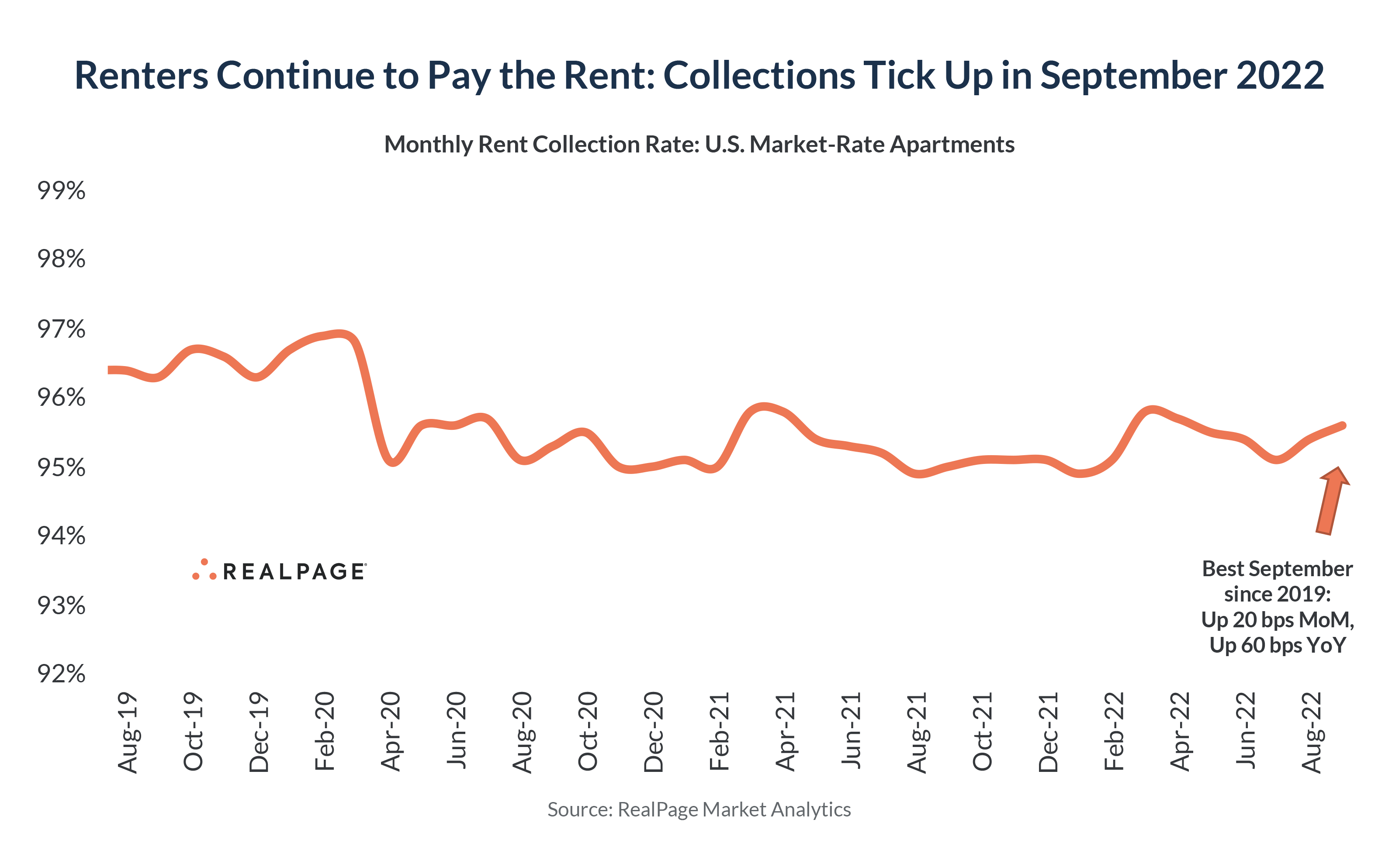Is Apartment Demand Weakening Due to High Rents? Look for These 3 Signals

We just witnessed the weakest 3rd quarter for apartment leasing in the 30+ years of tracking the U.S. apartment market. Net absorption registered moderately negative, occupancy ticked down and rents flattened. Is the slowdown due to renters hitting an affordability ceiling?
For most of us, our gut reaction to that question is probably, “Yes.” But what does the data tell us?
If affordability is the major reason, we should see three key signals: 1) Weakening rent collections, 2) a “flight to affordability” – a shift in demand toward cheaper submarkets and the more affordable Class C asset class, and 3) stagnating renter incomes. Let’s examine all three for clues.
1) Are Rent Collections Weakening?
Not yet. Rent collections – the share of rent due that renters pay each month – actually climbed UP in September. Collections improved 20 basis points (bps) month-over-month and 60 bps year-over-year to 95.6%. That marked the best September for rent collections since 2019.
The normal patterns held up in September, with collections registering highest in the most expensive Class A units (97.2%) catering to higher-income renters compared to 96.3% in Class B and 94.1% in Class C, according to data from RealPage Market Analytics. All three asset classes registered improvement year-over-year, with Class C surprisingly posting the biggest gain (up 80 bps) despite the lower overall rate. (Class C renters tend to have lower incomes and thus are more price sensitive than renters in Class A/B).
Inflation impacts us all, and that means for many of us, there’s less discretionary spending power. But so far, renters continue to pay the rent – even with most rental assistance programs winding down and few local eviction moratoria still in place.
This could change going forward, but so far it’s holding up.
2) Is There a “Flight to Affordability?”
Not yet. This is perhaps the best and clearest signal that the drop in leasing traffic and apartment demand is not simply about price. If affordability was the No. 1 hurdle, we would see a clear “flight to affordability” – meaning a shift in demand from higher-priced Class A to lower-priced Class C, and from more expensive submarkets into less expensive submarkets. But that’s not happening right now.
Occupancy nationally peaked in March 2022 and has been steadily decreasing since then in all three asset classes and in essentially all markets across the country. Occupancy in 3rd quarter fell roughly a full percentage point in all three groups.
A “flight to affordability” could still occur, but it’s not happening yet.
3) Are Renter Incomes Stagnating?
Not yet, although there are a couple caveats to this one. We track incomes among renter households signing a new lease. Those numbers have soared in the pandemic era, and that trend continued in 3rd quarter 2022 thanks to a tight labor market and low unemployment – an environment that has appeared to have especially benefitted young adults who are most likely to rent market-rate apartments.
Incomes among new lease signers jumped 11.6% year-over-year. Of course, the data does not cover renters renewing leases. (Incomes are typically collected only among new lease signers.) But the demand slowdown in 3rd quarter came on the new lease side – not renewals. Retention rates skyrocketed in the pandemic era and are certainly trending downward, but remain elevated compared to pre-pandemic norms. So the data suggests incomes alone don’t explain the drop in new lease demand.
Of course, there are some caveats to this from the laws of price elasticity. Demand can shift as price changes. Higher prices will send some households to the sidelines. Lower prices will encourage more households to search for an apartment. Certainly higher rents played some role in reduced leasing traffic this year, but the lack of a “flight to affordability” shift tells us this isn’t the biggest factor.
If It’s Not About Affordability, What is It?
Higher rents play some role, but the three key tell-tale signs of an affordability ceiling are not yet showing up. Additionally, we continue to see healthy job growth and low unemployment – which would normally be drivers for strong demand. So why did apartment demand slow down?
Here’s our theory: Inflation is contributing to weakened consumer confidence and heightened uncertainty. When people are unsure about the economic outlook and their personal financial security, human nature is to go into “wait and see mode.” We see this not only in the rental demand numbers, but also in the anemic for-sale housing numbers.
In other words: Americans have hit the “pause button” on their housing search.
That means we’re likely seeing an abrupt slowdown in household formation, which was the big driver of the housing demand boom of 2021.
While the official household formation stat is a lagging indicator, net new housing demand serves as an excellent proxy. We saw huge net new housing demand (for all types of housing) in 2021, leading many housing analysts to conclude that the Census’ official stats on household formation were likely understated. We could see the reverse effect in 2022.
One theory: It appears many May/June 2022 college graduates did not flood into the apartment market as they normally would. We didn’t see that seasonal bump in demand this summer. Could it be that recent college grads decided to wait it out at their parents’ house?
Additionally, in periods of uncertainty, combined households that might have otherwise decoupled could choose to stick it out together for a bit longer. Others could even choose to start doubling up – reversing some of the 2020-21 trend. Anecdotally, we’ve heard some of that occurring in downtown apartments among young adults wanting to live in pricier Class A apartments but choosing to now share those costs with a roommate.
One other likely factor: COVID and the resulting work-from-anywhere movement likely accelerated some future demand into 2021, “stealing” from 2022 to some degree. This was always expected going into 2022, although it’s difficult to measure its magnitude.
If indeed the “pause button” scenario plays out and the job market remains strong, we should see pent-up demand unlocked ahead of the spring 2023 leasing season. That’s a big “if,” but it’s difficult to imagine a different scenario absent a big jump in unemployment rates. And even if the job market did turn, we’d still likely see some pent-up demand unleashed among workers in less impacted job sectors.
Remember: At the end of the day, people need a place to live. You can work from anywhere and shop from anywhere. But you need a home. That’s a long-term tailwind for housing of all types.








